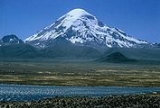
Sajama National Park
Encyclopedia
Sajama National Park is a national park
located in the Oruro Department
, Bolivia
. It borders Lauca National Park
in Chile
.
The park lies within the Central Andean dry puna
ecoregion
.. It features a spectacular Andean
landscape, with elevations ranging from 4200 to 6542 m (13,779.5 to 21,463.3 ft). It contains the snowy cone of Nevado Sajama
, the highest mountain in Bolivia. The park also includes the Nevados de Payachata
. On July 1, 2003, it was added to the UNESCO
World Heritage Tentative List due to its universal cultural and natural significance.
The reserve is jointly administered by park service officials and the indigenous people, the Aymara. It has proved an example of sustainable resource use and healthy tourism. As all protected areas in Bolivia are inhabited, nature conservation is not possible against the will of the local people. It is necessary to take their traditional rights, existing value systems and social organisation into account. Joint administration
National park
A national park is a reserve of natural, semi-natural, or developed land that a sovereign state declares or owns. Although individual nations designate their own national parks differently A national park is a reserve of natural, semi-natural, or developed land that a sovereign state declares or...
located in the Oruro Department
Oruro Department
Oruro is a department in Bolivia, with an area of 53,588 km². Its capital is the city of Oruro. At the time of census 2001 it had a population of 391,870.- Provinces of Oruro :...
, Bolivia
Bolivia
Bolivia officially known as Plurinational State of Bolivia , is a landlocked country in central South America. It is the poorest country in South America...
. It borders Lauca National Park
Lauca National Park
Lauca National Park is located in Chile's far north, in the Andean range. It encompasses an area of 1,379 km² of altiplano and mountains, the latter consisting mainly of enormous volcanoes. Las Vicuñas National Reserve is its neighbour to the south. Both protected areas, along with Salar de Surire...
in Chile
Chile
Chile ,officially the Republic of Chile , is a country in South America occupying a long, narrow coastal strip between the Andes mountains to the east and the Pacific Ocean to the west. It borders Peru to the north, Bolivia to the northeast, Argentina to the east, and the Drake Passage in the far...
.
The park lies within the Central Andean dry puna
Central Andean dry puna
The Central Andean dry puna is an ecoregion, in the Montane grasslands and shrublands biome, located in the Andean High plateau, in South America...
ecoregion
Ecoregion
An ecoregion , sometimes called a bioregion, is an ecologically and geographically defined area that is smaller than an ecozone and larger than an ecosystem. Ecoregions cover relatively large areas of land or water, and contain characteristic, geographically distinct assemblages of natural...
.. It features a spectacular Andean
Andes
The Andes is the world's longest continental mountain range. It is a continual range of highlands along the western coast of South America. This range is about long, about to wide , and of an average height of about .Along its length, the Andes is split into several ranges, which are separated...
landscape, with elevations ranging from 4200 to 6542 m (13,779.5 to 21,463.3 ft). It contains the snowy cone of Nevado Sajama
Nevado Sajama
Nevado Sajama is an extinct stratovolcano and the highest peak in Bolivia. The mountain is located in the Oruro Department, Sajama Province, Curahuara de Carangas Municipality, Sajama Canton. It is situated in the Sajama National Park in the southwest area of the country some 16–24 km from...
, the highest mountain in Bolivia. The park also includes the Nevados de Payachata
Nevados de Payachata
Nevados de Payachata is a north-south trending complex of potentially active volcanos on the border of Bolivia and Chile, directly north of Chungará Lake. The complex contains two peaks, Pomerape to the north and Parinacota to the south. According to helium surface dating, Parinacota has erupted...
. On July 1, 2003, it was added to the UNESCO
UNESCO
The United Nations Educational, Scientific and Cultural Organization is a specialized agency of the United Nations...
World Heritage Tentative List due to its universal cultural and natural significance.
The reserve is jointly administered by park service officials and the indigenous people, the Aymara. It has proved an example of sustainable resource use and healthy tourism. As all protected areas in Bolivia are inhabited, nature conservation is not possible against the will of the local people. It is necessary to take their traditional rights, existing value systems and social organisation into account. Joint administration

